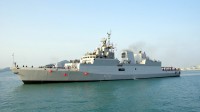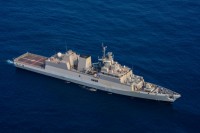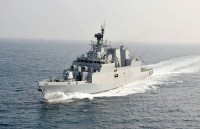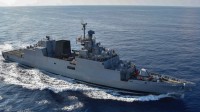Корветы типа «Каморта»
Основная информация
Главные размерения
Машина
- 4 * Pielstick 12PA 6 STC6 diesel engines
Персонал
Боевые силы и средства
- BEL Revathi 3-D E/F-band radar
- NPOL HUMSA-NG bow-mounted sonar
- BEL Lynx U1 fire-control radar
- IAC Mod C fire-control system
- 1 * Atlas Elektronik towed array sonar (to be fitted)
- Sanket electronic warfare system
- Kavach decoy launcher
- CMS-28 combat management system
- 1 * OTO Melara 76 mm Super Rapid Gun Mount (SRGM)
- 2 * AK-630M close-in weapon system
- 2 * RBU-6000 anti-submarine rocket launcher
- 4 * 533 mm DTA-53 torpedo tubes
- 1 * Ka-28PL or HAL Dhruv
The Kamorta-class corvettes or Project 28 are a class of anti-submarine warfare corvettes currently in service with the Indian Navy. Built at Garden Reach Shipbuilders & Engineers (GRSE), Kolkata, they are the first anti-submarine warfare stealth corvettes to be built in India. Project 28 was approved in 2003, with construction of the lead ship, INS Kamorta commencing on 12 August 2005. All of the four corvettes, INS Kamorta, INS Kadmatt, INS Kiltan and INS Kavaratti were commissioned in 2014, 2016, 2017 and 2020 respectively.
The platform and major internal systems of this class of corvettes are indigenously designed and built. The corvettes are named after the islands in the Lakshadweep archipelago.
The Kamorta class corvettes are intended to succeed the Kora-class corvette by precedence and Abhay-class corvette by role.
The order for four Kamorta-class corvettes were placed in 2003 by the Indian Navy. Construction of the lead ship, INS Kamorta began in the year 2005 and the keel was laid down in 2006 at Garden Reach Ship Builders and Engineers, Kolkata. The ship was launched in the year 2010 and was inducted into the navy in 2014 after a series of delays. Construction of the second ship in the row, INS Kadmatt followed and the keel was laid in 2007. The corvette was launched in 2011 and was inducted in the early 2016. INS Kiltan was laid down in 2010 and launched in 2013. While the last ship of its class, INS Kavaratti was laid down in 2012 and launched in 2015. Both the ships are expected to be completed by the end of 2017.
The project's objective was to enhance localisation and development of warship construction industry in India. The navy asked the Indian industries to deliver equipment of higher sophistication levels than usual. This led to some unforeseen delays in the product delivery, and struggles perfecting the products.
All the ships of this class are built using DMR 249A special grade high-tensile steel, produced by the state-owned Steel Authority of India Limited (SAIL), and carbon fiber reinforced plastic (CFRP) materials. The main machinery is raft mounted, and each gear unit and its associated engines are mounted on a common raft. The diesel engines are license built by Kirloskar under SEMT Pielstick of France. DCNS supplies the noise-suppressing raft-mounted gearbox for CODAD propulsion. Wärtsilä India manufactures the low-vibration diesel alternators to power the on-board electronics.
The ships also includes an integrated ship management system (ISMS) from L-3 MAPPS which combines an integrated platform management system and bridge management system into a single integrated system.
INS Kiltan and INS Kavaratti are to be more advanced than their elder ships. In a first, composite materials, imported from Kockums, Sweden, are used for the construction of the superstructures. This resulted in increased stealth features, reduced weight relative to typical superstructures built with steel, anti-corrosive and fire resistant. It's also projected for the ships to have some additional armament and new features.
In 2003, under the code name Project 28, the Indian Navy placed an order for four ASW corvettes. The corvette's design was originally planned to be based on the Russian corvette Project 2038.2, however the basic design was later provided by the Indian Navy's Directorate of Naval Design, followed by the detailed design by GRSE. The design includes many stealth ship features, including reductions in acoustic signature and vibration of the vessels.
The class incorporates some major features including but not limited to the 'X'-shaped hull form to improve stealth, a raft-mounted propulsion system to reduce vibration, and an infrared signature suppression system. It also includes networks such as the Total Atmospheric Control System (TACS), Integrated Platform Management System (IPMS), Integrated Bridge System (IBS), Battle Damage Control System (BDCS) and Personnel Locator System (PLS). The ships also include technology that enables them to fight in Nuclear, Biological and Chemical (NBC) warfare scenarios. The Indian Navy claims that the indigenisation achieved in these ships is about 90%.
The overall length of the Kamorta-class corvettes is 109 m (358 ft), and the beam spans 13.7 m (45 ft). The ships displace about 2,500 tonnes (2,500 long tons; 2,800 short tons) at standard load and 3,500 tonnes (3,400 long tons; 3,900 short tons) when fully loaded. Each ship retains a complement of 180 sailors and 13 officers.
They are propelled by four Pielstick 12 PA6 STC Diesel engines, each with a power of 5,096 hp (3,800 kW) in CODAD configuration. They also have two controllable pitch propellers which helps the ship achieve maximum speeds in excess of 25 knots (46 km/h; 29 mph).
The armament of the class includes a license-built OTO Melara 76 mm Super Rapid Gun in a stealth mount and a weapons layout similar to what is found on the Talwar-class and Shivalik-class frigate, two Larsen & Toubro built derivatives of the RBU-6000 anti-submarine rocket launcher, as well as Larsen & Toubro torpedo tube launchers, and a pair of AK-630M close-in weapon system (CIWS). The fire-control system is the Bharat Electronics IAC Mod C system.
There is an option on the ship to include surface-to-air missiles (SAM). But it is unclear as to which SAM will be integrated into the Kamorta-class corvette. Options include Barak 1 and the Barak 8. The corvette can hold one helicopter, which currently is a Westland Sea King Mk.42B helicopter.
Корабли4
- Комментарии
 ru
ru en
en uk
uk
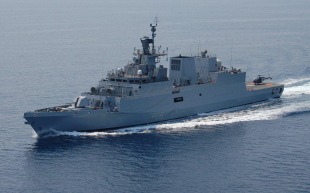


 Военно-морские силы Индии
Военно-морские силы Индии